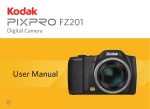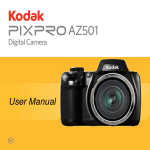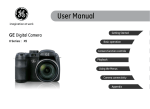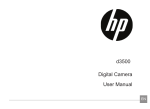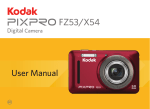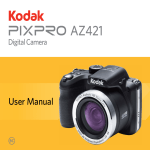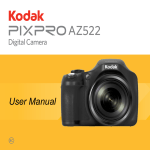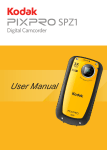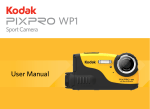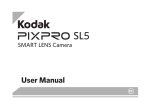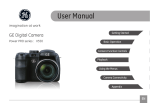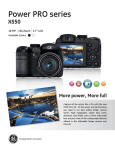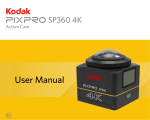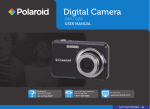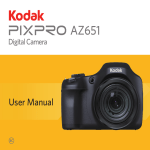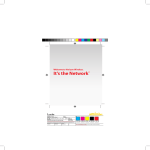Download User Manual - kodakpixpro.com
Transcript
User Manual BEFORE YOU START Declaration of Conformity Responsible Party: JK Imaging Ltd. Address:JK Imaging Ltd., 17239 South Main Street, Gardena, CA 90248, USA JK Imaging Europe, 71 Clarendon road, Watford, WD17 1DS, UK Company Website: www.kodakpixpro.com For Customers in the U.S.A. Tested to Comply with FCC Standards FOR HOME OR OFFICE USE This device complies with part 15 of the FCC Rules. Operation is subject to the following two conditions: (1) This device may not cause harmful interference, and (2) this device must accept any interference received, including interference that may cause undesired operation. For Customers in Europe "CE" mark indicates that this product complies with the European requirements for safety, health, environment and customer protection. "CE" marked cameras are intended for sales in Europe. This symbol [crossed-out wheel bin WEEE Annex IV] indicates separate collection of electrical waste and electronic equipment in the European countries. Please do not throw the equipment into domestic refuse. Please use the return and collection systems available in your country for proper, safe disposal of this product. 1 About this Manual Thank you for purchasing this KODAK PIXPRO Digital Camera. Please read this manual carefully and keep it in a safe place for future reference. JK Imaging Ltd. reserves all rights of this document. No part of this published manual may be reproduced, transmitted, transcribed, stored in a retrieval system or translated into any language or computer language, in any form, by any means, without the prior written permission of JK Imaging Ltd.. All trademarks mentioned in this manual are used for identification purposes only and are properties of their respective owners. This manual provides you with instructions on how to use your new KODAK PIXPRO Digital Camera. Every effort has been made to ensure that the contents of this manual are accurate, however JK Imaging Ltd. reserves the right to make changes without notice. Throughout this manual, the following symbols are used to help you locate information quickly and easily: Indicates useful information. In the instructions below, the following symbols may be used throughout this manual on how to operate the camera. This is to facilitate better understanding. 「Item properties」: 2 The optional properties in the camera interface are indicated by the symbol「 」. SAFETY NOTES Safety notes for this camera Do not drop the camera or allow it to hit solid objects. Do not attempt to disassemble the camera. To prevent the camera from being damaged by moisture, do not use or store the camera in very humid environments, such as in rain or near bodies of water. Do not use or store the camera in dusty places or on a beach to prevent dust or sand from entering the camera, causing possible damage to it. Do not use or store the camera in a hot environment or under direct sunlight. Do not use or store the camera near a powerful magnetic field, for example near a magnet or transformer. Avoid touching the lens of the camera. Do not expose the camera to direct sunlight for a long period time. Turn the camera off, remove the battery and the memory card, and dry it within 24 hours if water accidentally comes in contact with the camera. When you take the camera from a cold place to a warmer environment, condensation may occur. Please wait for a reasonable period of time before you turn it on. When you use the camera, remove the battery if it overheats. Wait until the unit cools down. Download your photos and remove the memory card when you are going to store the camera for a long period of time. Store the camera in a dry environment and place it on a flat surface when you are going to store the camera for a long period of time. Before you remove the battery and memory card, the camera should be turned off. When you clean the body of the camera, do not use abrasive, alcohol-based or organic cleaner. Use the professional lens wiping cloth and dedicated cleaner to wipe and clean the lens. 3 Safety notes for battery If battery fluid leaks inside the camera, contact our customer service department. Do not heat the battery or throw it into a fire to avoid a possible explosion. If battery fluid leaks onto your skin, rinse your skin with clean water and seek immediate medical attention. Do not store the battery in a hot environment or in direct sunlight. Disposal of used batteries should be carried out in accordance with the local (national or regional) regulations. To prevent the battery from being damaged, do not drop the battery or allow it to hit solid objects or to be scratched by the objects. Do not let the battery come in contact with metal objects (including coins) to avoid short circuiting, discharging, excessive heat, or possible leakage. Do not attempt to disassemble the battery. Do not expose the battery to water. Always keep the battery contacts dry. 4 When the camera is stored for a long period of time, remove the battery and keep it in a dry place that is not accessible to the infants and children. In a colder environment, the performance of the battery could be noticeably reduced. When you install the battery, install it according to the positive and negative markings on the battery compartment. Never force it into the battery compartment. Safety notes for memory card Do not drop the memory card or allow it to hit solid objects to avoid damaging it. Do not attempt to disassemble or repair the memory card. Do not expose the memory card to water. Always keep it dry. Do not remove the memory card when the camera is turned on. Otherwise, the memory card could be damaged. Do not directly edit the data on the memory card. Copy the data to your PC before you edit them. When the camera is stored for a long period of time, be sure to download your photos and remove the memory card. Store it in a dry environment. Do not modify the name of the files or folders of the memory card using your PC. Modifying the file names may cause the files to not be recognized on the camera or a possible error may occur. A photo taken with the camera will be stored in the folder that is automatically generated on the memory card. Do not store photos that are not taken using this camera in these folders as the pictures cannot be recognized during the playback. When you insert a memory card, make sure the notch of the card matches the markings on the top of the card slot. Format the memory card using the camera before you use it or insert a new one. We suggest buying only well-known, name brand memory cards to ensure peak performance. 5 Other Safety Notes Do not disconnect the power or turn the product off during the update process. Doing so may cause incorrect data to be written and the product may not power on later. Do not hang the neck strap of the camera around the neck of a child. When using your product on an airplane, observe the relevant rules specified by the airline. Due to the limitations of manufacturing technology, the LCD screen may have a few dead or bright pixels. These pixels do no effect the quality of the photos or video. Do not expose the LCD screen to water. In a humid environment, only wipe it with a soft and dry cleaning cloth. If the LCD screen is damaged, pay particular attention to the liquid crystal in the screen. If any of the following situations arise, take the recommended immediate action indicated below: 6 1. If liquid crystal comes in contact with your skin, please wipe with a dry cloth, wash thoroughly with soap, and rinse with plenty of clean water. 2. If liquid crystal gets into your eye, flush the eye immediately with plenty of clean water for at least 15 minutes and then seek for medical assistance. 3. If liquid crystal is swallowed, immediately flush your mouth thoroughly with clean water and induce vomiting. Seek for medical assistance. CONTENTS BEFORE YOU START.............. 1 SAFETY NOTES...................... 3 CONTENTS.............................. 7 GETTING READY...................11 MODE OVERVIEW................ 20 Display Setting.....................................20 LCD Screen Display.............................21 Overview of the screen icons in photo shooting mode.....................21 Overview of the Screen Icons in Movie Mode...................................23 Accessories Included...........................11 Overview of the Screen Icons in Playback Mode..............................24 Install lens cap and neck strap.............12 Using the Mode Dial.............................25 Part Names..........................................13 Auto Mode............................................26 Installing Battery and Memory Card.....15 Program AE..........................................27 Turn On / Off the Camera.....................17 Shutter Priority.....................................27 Set your Language, Date/Time............17 Aperture Priority...................................28 Set your Language, Date/Time after the first power-on...................17 Manual Mode.......................................28 Resetting your Language...............18 Resetting Date/Time......................19 Face Beautifier.....................................29 Panorama Mode...................................30 Scene Mode.........................................31 7 Auto Scene Mode (ASCN).............33 Custom Settings...................................35 BASIC OPERATION............... 37 Viewing Photos and Videos.................48 Thumbnail View....................................49 Using the Zoom Function.....................37 Using Zoom Playback (for still pictures only)........................................50 Focus Setting.......................................38 Photos and Video Deletion...................51 Macro Mode.........................................39 Slideshow.............................................52 Self-Timer Setting................................40 Flash Mode .........................................41 USING THE MENUS.............. 53 White Balance Setting..........................42 Photo Setup Menu...............................53 Continuous Shot...................................43 Expo Metering (Exposure Metering)......................53 EV Setting............................................44 Exposure Compensation...............44 ISO.................................................45 Shutter Adjustment........................45 Aperture Adjustment......................46 Using Quick Recording........................46 8 PLAYBACK............................. 48 i Button Function Menu........................47 Image Size.....................................54 OIS.................................................54 Cont. AF.........................................55 HDR...............................................55 Face Beautifier...............................56 Scene.............................................56 Photo Shooting Setting Menu..............58 HDR...............................................67 Quality............................................58 Touch-up........................................68 AF-Assist Beam.............................59 Rotate............................................69 Digital Zoom...................................59 Resize............................................70 Date Imprint...................................59 i button playback function.....................71 Quick Review.................................60 Playback Setting Menu........................72 Custom Settings............................60 Protect...........................................73 Face Detection...............................61 Delete............................................74 Movie Menu..........................................62 DPOF (Digital Print Order Format)................................75 Expo Metering (Exposure Metering)......................62 Trim................................................75 Video Quality.................................63 Setup Menu..........................................76 OIS.................................................63 Sound Settings..............................76 Movie Setting Menu.............................64 Power Saver..................................77 Digital Zoom...................................65 Power Saver..................................77 Custom Settings............................65 Language.......................................77 Playback Menu.....................................66 World Time.....................................77 Playback........................................67 Date/Time......................................78 9 LCD Brightness..............................78 Battery Type...................................78 File Settings.........................................79 Format...........................................79 Copy to Card..................................80 File Numbering..............................80 Reset.............................................81 FW Version....................................81 Setting the USB Mode...................87 Connecting to your Printer.............88 Using the PictBridge Menu...................89 Print (with Date).............................89 Print (without Date)........................90 Print Index......................................91 Print DPOF Images........................92 CONNECTIONS..................... 82 Exit.................................................92 Connecting to a Computer...................82 APPENDICES........................ 93 Setting the USB Mode...................82 Transferring files to your computer........................................83 Video System.......................................84 Set Eye-Fi Card Connection Mode......85 Supported HDMI Connections.............86 Connecting HDMI-Ready TV.........86 10 Connecting to a PictBridge Compatible Printer...............................87 Specifications.......................................93 Prompts and Warning Messages.........97 Troubleshooting................................ 101 GETTING READY Accessories Included Your camera box should contain the camera model you purchased along with the following accessories. If anything is missing or appears to be damaged, please contact your retailer. AA Alkaline battery × 4 Quick St Micro USB cable art Gui Lens cap with cord STOP de Quick start guide Neck strap Warranty card Service card 11 Install lens cap and neck strap 12 Part Names 1 . Zoom lever 4 56 78 9 10 2. Shutter button 3 3.Strap eyelet 3 2 1 4.Exposure compensation button 5.Continuous shot button 6.Power switch 11 7.AF assist beam/Self-timer lamp 12 9.Flash lamp 13 10.Flash button 8.Mode dial 1Microphone 1. 12 .Speaker 13 . Lens 13 14 . i button 14 15 16 1 5. Indicator lamp 17 1 6. Fast video recording button 1 7. Menu button 18 18 . Micro USB port 19 1 9. Micro HDMI port 20 21 22 23 20. AF button/Up button 2 1 . Flash button/Right button 22 . Delete button/Self-timer button/Down button 23 . Display button 24. Battery cover switch 30 29 28 27 26 25 24 25. Battery cover 26. Playback button 27. Tripod socket 28. Macro button/Left button 29. SET button 30. LCD 14 Installing Battery and Memory Card 1. Open the battery cover according to ①,②,③. 2. Insert the battery into the battery slot in the correct position as shown in the following diagram: 3 1 2 15 3. Insert the memory card into the memory card slot as shown in the diagram below: Write protection buckle The memory card (SD/SDHC) is optional and not included in all camera packaging. If you have to purchase a memory card, select one with storage capacity between 4GB and 32GB to ensure correct data storage. To remove your memory card, open the battery cover, gently press the memory card to eject it and remove it carefully. 16 4.Close the battery cover according to ①,②. 1 2 Turn On / Off the Camera Set your Language, Date/Time Slide the power switch to turn on/off the camera. Set your Language, Date/Time after the first power-on Power Switch 1. When you turn the camera on for the first time, the language selection screen appears. 2. Press the arrow buttons to select your desired language. 3. After you press the button to confirm the selection, the Date/Time settings screen appears. 4. Press the left/right arrow button to select the Date/Time to be adjusted: Time is displayed in yyyy:MM:dd HH:mm. When the camera power is off, pressing the playback button can power on the camera and directly enter playback mode. 5. Press the up/down arrow button to adjust the value for the selected Date/Time. 6. Press the button to confirm the time settings and the snapshot screen appears. 17 Resetting your Language After you set your language for the first time, follow the instructions below to reset your language. 1. Turn the power switch to turn on the camera. 2. Press the button, press the up/down arrow button to select , and press the button to enter the menu. 3. Press the up/down arrow button to select , and press the button or right arrow button to enter the menu. 4. Press the up/down arrow button to select 「Language」and press the button or right arrow button to enter the menu. 5. Press the arrow buttons to select your desired language and press the button to confirm. 6. Press the button and the snapshot screen appears. 18 Resetting Date/Time After you set your Date/Time for the first time, follow the instructions below to reset date and time. 1. Turn the power switch to turn on the camera. 2. Press the button, press the up/down arrow button to select , and press the button to enter the menu. 3. Press the up/down arrow button to select , and press the button or right arrow button to enter the menu. 4. Press the up/down arrow button to select 「Date & Time」and press the button or right arrow button to enter the menu. 5. Press the left/right arrow button to select the Date/Time to be adjusted: Time is displayed in yyyy:MM:dd HH:mm. 6. Press the up/down arrow button to press the value for your selected block. After you finish your settings, press the button to confirm. 7. Press the button and the following snapshot screen appears. 19 MODE OVERVIEW Display Setting Press the button to display the settings: Classic, Full, Off. Classic: Displays the camera parameters on screen SD 1234 16M 00:56:00 F3.0 1/50 -0.3 EV 400 ISO Full: Camera parameters with Grid and Histogram SD 1234 16M 00:56:00 F3.0 20 1/50 -0.3 EV 400 ISO Off: Does not display any additional icons on screen LCD Screen Display Overview of the screen icons in photo shooting mode 3 2 1 4 x1.0 6 7 19 8 18 1234 17 16M 16 15 1/50 -0.3 EV 14 13 400 ISO 12 9 10 00:56:00 F3.0 Auto Mode Face Beautifier Program AE Panorama Mode Shutter priority Scene Mode Aperture priority Custom Settings 5 SD 20 1 Shooting Mode Icons Manual Mode 2 Macro Mode 3 Zoom Display (By turning the Zoom Lever) 11 4 Memory Card/Built-In Memory 22 5 Battery Status 21 6 White Balance (Adjustable in SD 7 Color Effect (Adjustable in x1.0 23 Mode) Mode) 8 Number of remaining shots 24 25 1234 16M 9 Image Size 00:56:00 F3.0 1/50 -0.3 EV 400 ISO 21 10 Video Quality 11 ISO Value (Adjustable in Self-timer 2 sec Self-timer 10 sec Mode) 12 Remaining Recording time Self-timer Smile 13 Exposure Compensation (EV value) (Adjustable in Mode) 14 Shutter Speed (Adjustable in Mode) 15Histogram 16 Aperture Value (Adjustable in 17 Image stabilization 18 Focus Frame 19 Expo Metering AiAE Spot Center 20AF Mode Force Off Mode) Flash Auto Force Flash Slow Sync. Slow Sync. + Red-Eye Red-Eye Reduction 23 Continuous Shot Single Continuous Shot Single-AF 3 Shots Multi-AF Time-Lapse (30sec/ 1min/ 5min/ 10min) Object Tracking 21Self-Timer 22 22 Flash Mode Self-timer Off 24 Eye-Fi ON (with signal) 25 HDR (Adjustable in Mode) Overview of the Screen Icons in Movie Mode 1 2 3 5 4 7 Color Effect 8 Video Quality 9 Remaining Recording time 6 10 Exposure Compensation (EV value) 11 Image stabilization SD x1.0 12 Focus Frame 15 7 14 13 Eye-Fi ON (with signal) 14 Expo Metering 13 12 11 00:56:00 8 10 AiAE Spot -0.3 EV 9 Center 15 AF Mode 1 Movie Mode Icons 2 Macro Mode 3Self-Timer Self-timer Off Self-timer 10 sec 4 Zoom Display (by turning the Zoom Lever) Use an SD memory card with Class 4 or higher for the video recording. Optical Zoom and Digital Zoom can be adjusted (144X in total). Digital Zoom can be adjusted to 4X . 5 Memory Card/Built-In Memory 6 Battery Status 23 Overview of the Screen Icons in Playback Mode 1 2 3 1/45 SD 13 4 5 12 11 10 6 x2 7 8 0000 00-00 00:00 9 24 1 DPOF File 8 Image Zone 2 File Protection 9 Shooting Date 3 Memory space (indicating the current number of photos and total number of photos) 10 Eye-Fi ON (with signal) 4 Memory Card/Built-in Memory 11 Red-Eye Reduction 5 Battery Status 12 HDR 6 Zoom Magnification Area 13 Date Folder 7 Image Zoom Ratios Using the Mode Dial This camera provides a convenient mode dial that allows you to manually switch between different modes with ease. The available modes are listed below: Mode Name Shutter priority Aperture priority Description In this mode, the optimal conditions for taking pictures will be set based on the subject and environment. It is the most commonly used mode for taking pictures. Under different scenes, the user can switch the ISO and EV value according to personal preference, the camera can automatically set the shutter speed and aperture value. Setting allows you to choose a specific shutter speed so the camera will adjust the aperture automatically to ensure correct exposure. Allows you to choose a specific aperture and the camera will automatically adjust the shutter speed to match it. Manual Mode Many of the camera settings can be configured manually in this mode. Face Beautifier Panorama Mode This mode automatically enhances facial features with skin softening touches and eye brightening capabilities. Scene Mode Choose from 12 different pre-set scene types and effects for your photos. Movie Mode Record videos. Custom Settings The user can store the frequently used shooting modes and parameters and switch to this mode for quick adjustment. Auto Mode Program AE Icon You can take a panoramic photo in this mode. 25 Auto Mode Auto Mode is the easiest mode to take photos. While operating in this mode, the camera automatically optimizes numerous camera settings to adjust your photos and videos for the best possible results. SD Follow these steps: 1. Turn the power switch to turn on the camera. 2. Turn the mode dial to . 3. Compose your picture in the LCD screen and press the Shutter button halfway down to focus on the subject. 4. The LCD screen will show a green focus frame when the subject is in focus. 5. Press the shutter button all the way down to take pictures. 26 1234 00:56:00 Program AE Shutter Priority When (Program AE) mode is selected, you can adjust the EV value and ISO value. 1. Turn the mode dial to and press the button to configure settings. When (Shutter Priority) is selected, you can adjust the shutter speed, ISO value and EV value. The camera automatically sets the aperture value based on the shutter speed value and ISO value to get the most appropriate exposure value. 1. Turn the mode dial to and press the button to configure settings. F3.0 1/50 -2.0 EV 100 ISO 2. Press the left/right arrow button to select an adjustment item. 3. Press the up/down button to adjust the parameters. 4. Press the button to engage the settings and enter the shooting screen. F3.0 1/50 -1.3 EV EV -1.0 100 ISO 2. Press the left/right arrow button to select an adjustment item. 3. Press the up/down button to adjust the parameters. 4 Press the button to confirm the settings and enter the shooting screen. 27 Manual Mode Aperture Priority When selecting (Aperture Priority) mode, you can adjust the aperture size / EV value and ISO value. Selecting a large aperture opening will emphasize the point of focus and show a blurry background and foreground. A small aperture opening will keep both the background and main object in clear focus. 1. Turn the mode dial to and press the button to configure settings. When selecting manual ( ) mode, you can set the aperture / shutter speed manually and ISO value. 1. Turn the mode dial to and press the button to configure settings. F3.0 F3.0 1/50 -1.0 EV 100 ISO 2. Press the left/right arrow button to select an adjustment item. 3. Press the up/down button to adjust the parameters. 4 Press the button to confirm the settings and enter the shooting screen. 28 1/50 -1.0 EV 100 ISO 2. Press the left/right arrow button to select an adjustment setting. 3. Press the up/down button to adjust the parameters. 4. Press the button to confirm the settings and enter the shooting screen. Face Beautifier In Portrait Mode, the camera is set to automatically adjust camera exposure for realistic portrayal of skin tones. Beautifier Mode has 3 effects: • Effect 1: Skin Soften 1. Turn the mode dial to select Face Beautifier Mode ( ). • Effect 2: Skin Soften + Eye Brightening • Effect 3:Skin Soften + Eye Brightening + Eye Enlargement 2. Press the button and press the up/down button to select . 3. Press the left/right arrow button to select Face Beautifier effects and press the button to confirm and return to photo shooting mode. SD x3.6 1234 16M 00:56:00 -0.3 EV 400 ISO 29 Panorama Mode With Panorama Mode, you can take a series of pictures which will be stitched automatically into a ultra-wide panoramic picture by the camera. Follow the steps below: 1. Turn the mode dial to Panorama Mode ( ). 2. Press the arrow buttons to select a shooting direction. (The right direction is used as default if you do not make any choice) 2 seconds later, the camera is ready to take pictures. You can also press the button or half press the shutter button to be ready to take pictures. 3. Compose the first view of the panoramic picture on the LCD screen and press the Shutter button to capture the image. Cancel 30 Save 4. When you finish shooting the first photo, two target icons will display on the LCD screen at left and right sides. Move the camera to the right until the round target icon is directly positioned over the square box. The box will turn green when they overlap and the camera will automatically take the next picture. Repeat the same steps for additional shots. Up to 4 frames can be stitched together. 5. If continuous pictures are less than 4 shots, press the button and the camera will stitch the pictures automatically. Press the playback button to enter playback mode to see the effect. 6. If you take 4 pictures, the camera will automatically stitch the pictures. Press the playback button to enter playback mode to see the effect. Scene Mode Flash Mode, Self-Timer, Macro Mode, and Exposure Compensation are all disabled in Panorama Mode. In the process of shooting in the panoramic mode, when the LCD screen shows “Improper alignment. Please try again.”, it means that in the process of camera moving, the moving angle is off the green line, shooting can't be done. You will have to try again. You can select an appropriate mode from the 12 scene modes according to the type of environment you are shooting. The camera then configures the most appropriate settings automatically. Turn the mode dial to the Scene Mode to enter the Scene Mode menu. What the LCD screen displays is shown in the screen shot below: Night Portrait In order to guarantee the shooting effect in the panoramic mode, please keep moving horizontally and reduce the shake in the process of camera movement. In Panorama mode, up to 4 photos can be captured when the image size is set at 2MP. Press the arrow buttons to select a scene, and press the button to confirm. 31 Scene Rapidly identify pet (dog/cat), capture the dynamic moment of pet. Sunset For sunsets. Capture subjects in strong sunlight. Fireworks For fireworks at night. The use of a tripod is recommended. Sport For fast-moving subjects. Capture sharp, action shots with minimal blur. This mode is not recommended for shooting indoors. Night Portrait For portraits against night scenery. Landscape For landscapes and outdoor shots. Vivid reproduction of green and blue. Portrait Most suitable for capturing people with focus on their face. Snow For snow scenes. Reproduce natural, clear white scenes. Children Party 32 Description Pet Mode Turns off flash automatically. Avoids disturbing subject, suitable for taking photos of children. Suitable for taking indoor party pictures, even under the complicated lighting conditions. Night Landscape For night scenes. The use of tripod is recommended. Auto Scene Identifies the scene automatically: Person, Backlighting, Landscape, Macro, Night Scene, Night Scene Person, Auto. Auto Scene Mode (ASCN) In “ASCN” scene mode, the camera can detect different environments intelligently and automatically select the best scene and photo settings for you. “ASCN” can intelligently detect the following scenes: Icon Mode Name Landscape Mode Night Portrait 2. Hold the camera steadily and aim at the subject. The optimum scene mode will be selected automatically. Backlit Portrait 3. Press the shutter button half-way down to focus. Night Landscape Mode 4. Press the shutter button all the way down to take pictures. Portrait Mode Macro Mode Auto Mode To use "ASCN": 1. Turn the mode dial to “SCN” and select “ASCN” mode. 33 Mode Name Landscape Mode 34 Description For landscapes, will automatically adjust the exposure and reproduce vivid green and blue colors. Portrait Mode Most suitable for capturing people with focus on their faces. Night Portrait When you take portraits at night, or in low light conditions, ASCN will automatically adjust the exposure for people and night scenes. Backlit Portrait When the sun or any other light source is behind you, will automatically adjust the foreground exposure to produce the best pictures possible. N ight Landscape Mode For night scenes, ASCN will automatically increase the ISO value to compensate for low light. Macro Mode To produce more detailed close-ups, will automatically engage the camera's Macro Mode and automatically focus the lens. Auto Mode The camera will automatically adjusts the exposure and focus to ensure the best possible pictures. Custom Settings The user can store the frequently used shooting modes and parameters and switch to this mode for quick adjustment. Settings under after reset): mode (unset state or state 1. Turn the mode dial to select the mode, and enter the setup screen, as shown in the figure below: Go to setting CS mode Yes Or Rotating the mode dial to skip . Select one capture mode to define CS . For setting under other modes (use this method to select a different custom setting): Landscape Save Exit 2. As shown in the above figure, press the left/right arrow buttons to select a scene, and press the button to enter the shooting screen. 3. As shown in the above figure, press the button, and choose whether to continue the mode setting. 1. Select any mode or scene mode to be stored. 2. Set your desired parameters in the current mode. 3. Press the button, press the up/down arrow button to select , and press the button to enter the menu. 4. Press up/down arrow button to select , and press the button or right arrow button to enter the menu. 35 5. Press the down arrow button select「Custom Settings」and press the button or the right arrow button to enter the menu. 7. Turn the mode dial to switch to the custom settings ( ). 8. The photo settings you stored the last time are invoked. When the mode is used for the first time, there is no preset parameter stored in the mode. 6.Select「Yes」to save or「No」to cancel. Under the mode, if you need to retain or modify the set parameters (except the parameters in ) in restart or all modes. Please enter the 「Custom Settings」menu and select 「Yes」after setup. Otherwise, the parameter settings are not retained in the case of switching on/off or mode switching. If you want to remove the parameter setting of 「Custom Settings」, please see the reset function on page 81 to operate. 36 BASIC OPERATION Using the Zoom Function Your camera is equipped with two types of zoom functions: Optical Zoom and Digital Zoom. Toggle the Zoom Lever of the camera to zoom in or out of the subject while taking pictures. SD Zoom Indicator 1234 00:56:00 -0.3 EV 400 ISO Zoom Lever When the Optical Zoom reaches the threshold as Digital Zoom, release and turn the Zoom Lever to T to switch between the Optical zoom and Digital zoom. 37 Focus Setting In different photo shooting modes, you can select different focus methods. 1. Press the up arrow button ( ) to display the settings screen. Object Tracking Smart tracking of the object in motion under the focusing shooting. 3. Press the button to confirm the settings and exit the menu. Once enabled, Object Tracking will only work when lens is focused on the object. Single-AF 2. Press the left/right to select the following 3 modes: Single-AF The focus frame appears on the center of the LCD screen to focus on the subject. Multi-AF The camera automatically focuses the subject in a wide area to find the focus point. 38 Macro Mode The Macro Setting is ideal for shooting small objects or close-up photos. This mode allows you to focus on subjects very close to the camera. 1. Press the left arrow button ( ) to enter the Marco Menu. Macro Off 2. Press the left/right to select the following 2 modes: • Macro Off Select this option to disable Macro. • Macro On Select this option to make focusing on the object closer to the lens (At the W side, the shooting distance should be more than 1.6 cm). 3. Press the button to confirm the settings and exit the menu. 39 Self-Timer Setting Using this function can take photos at regular time. The camera can be set to shoot after 2 seconds, 10 seconds since pressing the shutter or shoot after smile. 1. Press the down arrow button ( enter the self-timer menu. • Self-timer 10 sec A single picture is shot 10 seconds after the Shutter Button is pressed. • ) to Self-timer Smile Press the Shutter Button and a picture will be taken immediately after a smile is detected. 3. Press the button to confirm the settings and exit the menu. Self-Timer Off 2. Press left/right to select the following 4 modes: 40 • Self-timer Off Disables the Self-Timer. • Self-timer 2 sec A single picture is shot 2 seconds after the Shutter Button is pressed. When enabling the self-timer, pressing the shutter or Down arrow button can disable the self-timer and return to the shooting screen, and keep the self-timer setting. When enabling the smile detection, pressing the shutter or button can disable the self-timer without keeping the self-timer setting. Flash Mode The flash is mainly for supplementing light for the scene. The flash is usually used in shooting against the light to highlight the object shot through lightening the object while darkening the background; it is also suitable for metering and shooting in darker scenes through exposure. 1. Press the Flash Button to pop up the flash. 2 2. Press the right arrow button ( the Flash Settings Menu. 1 • • • • • • ) to enter ਘ⥺斿Ұ Force Off ܠ昘旅 3. Press the left/right to select the following 6 modes: Force Off Flash is turned off. Flash Auto Camera flash goes off automatically based on existing light conditions. Force Flash The flash will engage with each shot even if there is enough available light to take the photo without flash. Slow Sync. This allows for night scenery photos that include people in the foreground. The use of a tripod is recommended when shooting with this setting. Slow Sync. + Red-Eye Use this mode for slow synchro shots with red-eye reduction. Red-Eye Reduction The camera emits a brief pre-flash before the picture is taken to reduce red-eye effects. 4. Press the button to confirm the settings and exit the option. 41 White Balance Setting The white balance function allows adjustment of the color temperature for different light sources (Adjustable in Mode). • AWB • Daylight Follow the steps below to set white balance of the camera: • Cloudy • Fluorescent • Fluorescent CWF • Incandescent • Manual WB (Fully press the shutter button to detect the white balance value) • Color Temp. (1900K~10000K) Press direction buttons Up / Down to "Adjust the K value"; Press the direction button Left to exit the K value. 1.Press Menu. button to enter White Balance AWB AWB 2. Press the left/right to select the following 8 modes: 42 3. Press the button to confirm the settings and exit the menu. Continuous Shot Follow the steps below to configure the Continuous Shot Settings: 1. Press the Menu. to enter the Continuous Shot • 3 Shots • Time-Lapse Take pictures based on the preset interval (30sec/ 1min/ 5min/ 10min). 3. Press the button to confirm the settings and exit the menu. 4. Press the Shutter button to start continuous shooting. Single The flash is disabled in this mode in order to achieve quick succession of shots. 2. Press the left/right to select the following 4 modes: • Single • Continuous Shot 43 EV Setting The EV function menu of the camera includes functions, such as EV adjustment, ISO, Shutter Adjustment, Aperture Adjustment, etc. Using the appropriate function settings can improve your pictures. To select the best setting for optimum photos, follow these steps: 1. Press the screen. Exposure Compensation Set up to adjust the picture brightness. In the case of a very high contrast between the photographed object and the background, the brightness of the picture can be appropriately adjusted. (Adjustable in Mode) button to display the settings 2. Press the left/right arrow button to select the setting options. F3.0 1/50 -2.0 EV 100 ISO The adjustable range of exposure value is from EV -2.0 to EV+2.0. F3.0 1/50 -2.0 EV 100 ISO 3. Press the up/down button to adjust the option values. 44 4.Press button to complete the setting and enter shooting mode. ISO Shutter Adjustment The ISO function allows you to set the sensitivity of the camera's light sensor based on the brightness of the scene. To improve the camera's sensor performance in darker environments, a higher ISO value is required. A lower ISO value is needed when shooting in brighter conditions. For shutter speed, the camera may automatically set the aperture value corresponding to the manually set shutter speed so as to obtain a most suitable exposure value. The movement of object may be shown by adjusting the shutter speed. High shutter value can make you clearly capture the movement of fast moving object while low shutter value can allow you to take a picture for fact moving object with a strong sense of movement. (Adjustable in Mode) Pictures taken at higher ISO settings will generally have more noise than those taken at lower ISO settings. (Adjustable in Mode) F3.0 1/50 +0.7 EV 400 ISO F3.0 1/50 -1.3 EV EV -1.0 100 ISO The camera's ISO settings include: automatic, 80 100, 200, 400, 800, 1600 and 3200. 45 Using Quick Recording Aperture Adjustment You can adjust the aperture size value. Selecting a large aperture opening will emphasize the point of focus and show a blurry background and foreground. A small aperture opening will keep both the background and main object in clear focus. (Adjustable in Mode) In shooting mode, press the Recording shortcut button to begin recording video. After finishing, press the Recording short cut button or the Shutter Button to stop and store the video. The camera will return to shooting mode automatically. F3.0 46 1/50 -1.0 EV 100 ISO i Button Function Menu Mode: The Image Color Setting allows you to select different color effects. 1. Press the button to select the Image Color Setting Menu. 2. Press the left/right arrow button to select the Image Color Setting options. • Sepia • Black and White • Vignetting • Salon • Dreamy There are 4 Image Color options in Movie Mode : Normal • Normal • Vivid • Sepia • Black and White There are 7 Image Color options in photo shooting mode : • Normal • Vivid 47 PLAYBACK Viewing Photos and Videos To view photos and videos on LCD screen: 1. After pressing the screen. button, the last photo or video clip taken will be displayed on the LCD 2. Use the Left/Right navigation buttons to scroll through the photos or video clips stored in the internal memory or on the memory card. 3. To play a selected video clip, press the button to enter the Movie Playback Mode. An operation guide appears on the screen when playing back a video. Press the appropriate buttons to enable the corresponding functions. Play mode Pause mode Mute 00:00:47 1 2 3 4 5 48 Increase Volume Pause Fast Forward Decrease Volume Rewind 00:01:23 00:00:47 6 7 8 9 10 00:01:23 Back to the beginning of the video Play Play video forward Cancel playback Play video backward Thumbnail View When in Playback Mode, rotate the Zoom Lever counter clockwise to the position to display thumbnail images of the photos and videos on the screen. (the picture is displayed in horizontal position) W Zoom Out T Zoom In 2. Press the arrow buttons to select a picture or video clip to view and press the button to restore it to the original size. If the indicator appears on the LCD, then a movie file is currently being displayed. 1. Slide the Zoom Lever to switch between 3x3 and 4x4 thumbnails. 49 Using Zoom Playback (for still pictures only) When playing back photos, you can also use the Zoom Slider to zoom in on the photos 2 to 8 times. 1. Press the button to switch to Playback Mode. 2. Press the left/right button to select a picture to be zoomed in. 3. Rotate the Zoom Lever clockwise to ( ) to zoom in. 4. The bottom right corner of the screen will display the number of times and area of the photo zooming operation. x2 5. Press the arrow buttons to navigate and select a part of the image to be zoomed in. 6. Press the button to return the image to its original scale. Movie images cannot be magnified. 50 Photos and Video Deletion In playback mode, press the down arrow button to delete your photos and videos. To delete photos or videos: 1. Press the button to switch to playback mode. 2. Press the left/right arrow button to select the photos and videos to be deleted. 3. Press the down arrow button and the deletion screen is displayed. 4. Press the up/down arrow button to select 「Delete One」or「Exit」and press the confirm. button to Erased photos/video clips cannot be recovered. Please refer to page 74 for instructions on deleting more than one image at a time. 51 Slideshow You can use this setting to view the pictures taken by the method of slide playing. 1.Press button to enter playback screen. 2.Press button to enter the slide option (except for video file). 3. Press the left/right button to select slideshow playing or 「Cancel」 to return to the playback screen. 52 4. Press the button to confirm the setting. Pictures rotate automatically during a slide show. Slide playing function supports movie playing. USING THE MENUS Photo Setup Menu Mode: 1. In Photo Shooting Mode, press the button to enter the Photo Shooting Menu. Expo Metering (Exposure Metering) Use this setting to select the "target" size of the camera's field of view to be metered. 2. Press the up/down arrow button to select the Photo Shooting Menu to be set. 3. Press the left/right arrow button to select the Photo Shooting Menu to be set and press the button to confirm. Refer to the following pages for more details about each setting. There are 3 options: • AiAE (Artificial Intelligence AE) targets the camera's entire field of view. • Spot metering targets a small area in the center of the camera's field of view. • Center metering targets a slightly larger area in the center of the cameras field of view. AIAE (Artificial Intelligence AE): Automatically selects the central and peripheral metering, to calculate the reasonable value of metering by weighting. 53 Image Size OIS The size setting refers to the image resolution in pixels. A higher image resolution allows you to print that image in larger sizes without degrading the image quality. This mode can help reduce photo blur caused by unintentional hand shake, or low light. The bigger the number of recorded pixels is, the better the image quality becomes. As the number of recorded pixels lessen, you will be able to record more images on a memory card. 54 Use this image stabilization mode in dark environments. Shooting in a windy or unstable environment (such as a moving vehicle) may cause blurred images. Cont. AF HDR Enable the continuous AF to be able to continuously focus automatically when taking pictures. Use this setting to control wide dynamic image range when taking static pictures. Photos with extreme contrast of bright and dark areas will still maintain distinguishable detail and depth. (Use of tripod is recommended) There are 2 options: • Off • On There are 2 options: • Off • On In the scenario with high light contrast (too dark or too light), this function can be used to shoot satisfactory photos. 55 Face Beautifier Scene Set the effect of the Face Beautifier mode. Select the scene mode under the SCN mode. Press SET To Select Scene Night Portrait 16M Face Beautifier Mode has 3 effects: 56 • Effect 1:Skin Soften • Effect 2:Skin Soften + Eye Brightening • Effect 3:Skin Soften + Eye Brightening + Eye Enlargement • Shooting menu in the shooting mode (Ο: Optional Х: Not optional) Shooting Modes Options 16M Ο Ο Ο Ο Ο Ο Ο Ο Ο Ο Ο Ο Ο Ο Ο Ο Ο Ο Ο Ο Ο Ο Ο Ο Ο Ο Ο Ο Ο Х Х Х Х Х Х Ο 57 Photo Shooting Setting Menu Mode: 1. Press the button in Photo Shooting Mode and press the up/down button to select . 5. Press the up/down arrow buttons to select an option and press the button to confirm. Quality The Quality Setting can be used to adjust the image compression ratio. 2. Press the button to enter the menu. 3. Press up/down arrow button to select , and press the button or right arrow button to enter the menu. 4. Press the up/down arrow button to select the item to be set and press the button or right arrow button to enter the menu. 58 There are three options for picture quality: • Best (16M Average File Size: 4.0MB) • Fine (16M Average File Size: 2.6MB) • Normal (16M Average File Size: 2.2MB) AF-Assist Beam Date Imprint In a darker environment, AF Assist Beam can be turned on for better focus. Include a Date/Time stamp on the photo image. Digital Zoom Turn on or off the digital zoom. • Off • Date • Date / Time 59 Quick Review Custom Settings This option allows quick review of the photos immediately after they are taken. Each photo is displayed on the LCD screen based on the selected time. Custom Settings stores the current photo shooting mode and its parameters. The stored mode and parameters are directly invoked in Custom Settings mode. There are 4 options: There are 2 options: • Off • No • 1 sec • Yes • 2 sec • 3 sec 60 Face Detection For detecting and focusing on faces to make all faces as clear as possible in photo mode. There are 2 options: • Off • On 61 Movie Menu Mode: Expo Metering (Exposure Metering) 1. Turn the mode dial, select the mode and press the button to enter the Movie Menu. Use this setting to select the "target" size of the camera's field of view to be metered. 2. Press the up/down arrow button to select the Movie Menu to be set. Expo Metering: AiAE 3. Press the left/right arrow button to select the Movie Menu to be set and press the button to confirm. There are 3 options: 62 • AiAE (Artificial Intelligence AE) targets the camera's entire field of view. • Spot metering targets a small area in the center of the camera's field of view. • Center metering targets a slightly larger area in the center of the cameras field of view. * The longest recording time is 29 AIAE (Artificial Intelligence AE): Automatically selects the central and peripheral metering, to calculate the reasonable value of metering by weighting. minutes at one time. When recording in higher pixel resolutions for extended periods of time, this can cause the camera to generate heat. This is not a camera malfunction. Video Quality Set the image resolution used during video recording. OIS This mode can help reduce photo blur caused by hand shake, low light and slow shutter speed. Size: 720p 30fps OIS: Off The speed requirements for reading and writing high image pixel images to memory card are as follows: No. Image Pixel Frame Recom mendation 1 1280x720 * Recording time (4GB) About 30 Class 6 58 minutes 2 1280x720 15 Class 4 61 minutes 3 640x480 30 Class 4 69 minutes Use this image stabilization mode in dark environments. Shooting in a windy or unstable environment (such as a moving vehicle) may cause blurred images. 63 Movie Setting Menu Mode: 1. Turn the mode dial and select the video recording screen. to enter 2. Press the button, press the up/down arrow button to select , and press the button to enter the menu. Press SET To Enter Menu 3. Press up/down arrow button to select , and press the button or right arrow button to enter the menu. 64 4. Select the items to be set and press the button or the right arrow button to enter the menu. 5. Press the up/down arrow buttons to select an option and press the button to confirm. Digital Zoom Custom Settings Turn on or off the digital zoom. Custom Settings stores the current movie shooting mode and its parameters. The stored mode and parameters are directly invoked in Custom Settings mode. 65 Playback Menu Mode: 1. Press the button to display the playback screen and press button to enter the menu. 2. Press the up/down arrow button to select the playback to be set and press 3. Press the left/right arrow buttons to select an option and press the Photo Video Press SET To Confirm Press SET To Confirm Normal Mode Normal Mode Refer to the following pages for more details about each setting. 66 button to enter. button to confirm. Playback HDR 1. Press the button, select the settings, and press the button to display the settings screen. With the HDR function, pictures that are overexposed may be corrected to optimize the highlights and lowlights captured to more accurately represent the actual scene. 2. Press the left/right button to select from the following 2 functions: Normal Mode: Display all images. Date Mode: Arranged by date. 1. In Playback Mode, press the left /right arrow button to select the photos to be edited. 2. Press the button, select the settings, and press the button to display the settings screen. 3. Press the left/right button to select whether HDR is used. Normal Mode: Display all images. 3. Press the button to confirm the setting. The Date Folder is displayed in date order based on camera's Date/Time Settings. 67 Touch-up 1. In Playback Mode, press the left /right arrow button to select the photos to be edited. 2. Press the button, select the settings, and press the button to display the settings screen. : HDR 3. Press the left/right button to select Touchup options or「Cancel」to return to the playback Screen. : Cancel 4.After using the HDR function, the image will be saved as a new file and the original file is still stored in the memory. : Red-Eye Reduction : Skin Soften : Eye Brightening : Eye Enlargement : Cancel 68 Rotate 4. Press the button to confirm the setting. The Touch-up mentioned here is the individual beautification for three effects, beauty mode allows you to select from single, two, or all three effects combined. You can use this setting to change the orientation of the picture. 1. In Playback Mode, press the left /right arrow button to select the photos to be edited. 2. Press the button, select the settings, and press the button to display the settings screen. 3. Press the left/right button to select the rotation direction or「Cancel」to return to the playback Screen. : Turn Right : Turn Left : Cancel 69 Resize 4. Press the button to confirm the setting. Videos and panoramic pictures cannot be rotated. The rotated picture file will replace the original photo. This setting allows you to resize a picture to a particular resolution and saves it as a new picture. 1. In Playback Mode, press the left/right arrow button to select the photos to be edited. 2. Press the button, select the settings and press the button to display the settings screen. 3. Press the left/right arrow button to select 「1024」or「640」or select「Cancel」to return to the playback Screen. : Resize to 1024x768 : Resize to 640x480 : Cancel 70 4. Press the button to confirm the setting. i button playback function This setting allows you to change the picture color effect. The file is saved as a new photo and stored in memory together with the original photo. 1. In Playback Mode, press the left/right arrow button to select the photos to be edited. 2. Press the button to select the Image Color Setting Menu. 3. Press the left/right button to select the corresponding menu or「Cancel」to return to the playback Screen. There are 8 options: • Cancel • Vivid • Sepia • • Grainy • Vignetting • Salon • Dreamy Black and White Cancel 4. Press the button to confirm the setting. 71 Playback Setting Menu Mode: 1. Press the button to show the playback screen, press the button, and press the up/down button to select . 5. Press the up/down arrow buttons to select an option and press the button to confirm. 2. Press the Refer to the following pages for more details about each setting. button to enter the menu. 3. Press up/down arrow button to select , and press the button or right arrow button to enter the menu. 4. Press the up/down arrow button to select the item to be set and press the button or right arrow button to enter the menu. 72 Protect To prevent any pictures or videos from being accidentally erased, use this setting to lock one or all of the files. There are 4 sub menus available: • One Lock the selected photo or video if they are unprotected; unlock the selected photo or video if they are protected. • Date Folder Protect all photos in the Date Folder. • All Lock all photos or videos. • Reset Cancel all locked photos or videos. To lock or unlock the photo and video files: 1. Press the up/down arrow button to select 「Protect」and press the button or right arrow button to enter the sub-menu. 3. Press the up/down arrow buttons to select an option and press the button to confirm. 2. Press the up/down arrow button to select the sub-menu and press the button or right arrow button to show the settings screen. 73 Delete You can delete one or all photo/video files. There are 3 sub menus available: • One Delete one photo or video. • Date Folder Delete all photos in the Date Folder. • All Delete all photos or videos. 3. Press the up/down arrow buttons to select an option and press the button to confirm. To delete photo or video files: 1. Press the up/down arrow button to select 「Delete」and press the button or right arrow button to enter the submenu. 2. Press the up/down arrow button to select the submenu and press the button or right arrow button to show the settings screen. The “ ” indicator means a file is protected. File protection must be removed first before a file can be deleted. Deleting files will cause DPOF settings to be reset. When a single photo is protected in the date folder, the protected photo will be kept and other photos will be deleted. 74 DPOF (Digital Print Order Format) Trim The DPOF feature allows you to compile and select a group of pictures that you would like to print and will save your selection on the memory card so that you can use the memory card to print without having to individually specify the photos you want to print. The Trim Setting allows you to crop photos and save them as new pictures. The printer that supports DPOF is needed for printing. 1. Press the up/down arrow button to select「Trim」and press the button or right arrow button to enter the menu. 2. Select「Yes」to confirm trim. Select a part to be trimmed using the Zoom Lever and arrow buttons to trim a photo. 3. Press the button and the 「Save Change?」prompt appears. Select 「 」to change and save the picture. Select「 」to cancel changes and return to the trim prompt screen. The image cannot be clipped/trimmed again once it has been clipped to 640X480. 75 Setup Menu Mode : 1. Press the button in any mode and press the up/down button to select . 2. Press the button to enter the menu. 3. Press up/down arrow button to select , and press the button or right arrow button to enter the menu. Refer to the following pages for more details about each setting. Sound Settings To change this setting: 1.Select「Sound Settings」in the basic settings menu. Press the button or right arrow button to enter the menu. 2. Press the left/right arrow button to select an option. 4. Press the up/down arrow button to select the item to be set and press the button or right arrow button to enter the menu. 5. Press the arrow buttons to select an option and press the button to confirm. 76 3. Press the button to confirm. Power Saver Language This setting allows you to save power and get the maximum possible running time for your camera's batteries. Follow the steps below to turn the LCD screen and camera off automatically after a consecutive period of inactivity. 1.Select「Power Saver」in the basic settings menu. Press the button or right arrow button to enter the menu. 2. Press the up/down arrow button to select an option. Refer to the “Reset your language” section on page 18. World Time The Zone setting is a useful function for your overseas trips. This feature enables you to display the local time on the LCD screen while you are abroad. 1.Select「World Time」in the basic settings menu. The World Time screen appears. 2. Press the up/down to select the departure place ( ) and destination ( ) fields. 3. Press the left/right arrow button to select a city located in the same time zone as that of the field. Press the button to confirm settings. 3. Press the Power Saver Auto Normal Best button to confirm. 3 min Turn off time 5 min 1 min 30 s 3 min 1 min LCD power off time 77 Date/Time Battery Type Refer to the “Reset Date/Time” section on page 19. Please choose the right type of battery before using. LCD Brightness 1.Select「BATTERY TYPE」in the basic settings menu. Press the button or right arrow button to enter the menu. Use this setting to adjust the brightness of your LCD screen. 1.Select「LCD Brightness」in the basic settings menu. Press the button or right arrow button to enter the menu. 2. Press the up/down arrow button to select an option. ALKALINE Normal 2. Press the up/down arrow button to select an option. BATTERY TYPE +2 Normal LCD Brightness +1 Normal -1 -2 3. Press the 78 button to confirm. 3. Press the button to confirm. NI-MH File Settings Format Please note: formatting enables you to delete all contents in the memory card and built-in memory, including protected photo and movie files. To use this setting: 1. Press the button, press the up/down arrow button to select and press the button to enter the menu. 2. Press up/down arrow button to select and press the button or right arrow button to enter the menu. 3. Press the up/down arrow button to select「Format」and press the button or right arrow button to enter the menu. 4. Press the up/down arrow buttons to select「Yes」or「No」and press the button to confirm. 5. If you select「Yes」the camera formats its memory. If there is no memory card in the camera, the built-in memory will be formatted; if there is a memory card, it will be formatted only. 79 Copy to Card File Numbering Use this setting to copy the files stored in the internal memory to an memory card. 1. Press the button, press the up/down arrow button to select and press the button to enter the menu. 2. Press up/down arrow button to select and press the button or right arrow button to enter the menu. After you take a picture or video clip, the camera will save it with a sequential number. You can use this to reset the file numbering to 0001. 1. Press the button, press the up/down arrow button to select and press the button to enter the menu. 3. Press the up/down arrow button to select 「Copy to Card」and press the button or right arrow button to enter the menu. 4. Press the up/down arrow buttons to select「Yes」or「No」and press the button to confirm. If there is no card available in the camera, this function will not be displayed. 80 2. Press up/down arrow button to select and press the button or right arrow button to enter the menu. 3. Press the up/down arrow button to select 「File Numbering」and press the button or right arrow button to enter the menu. 4. Press the up/down arrow buttons to select「Yes」or「No」and press the button to confirm. Reset FW Version Use this setting to restore the camera to its original default settings. Use this setting to view the current camera firmware version. 1. Press the button, press the up/down arrow button to select and press the button to enter the menu. 1. Press the button, press the up/down arrow button to select and press the button to enter the menu. 2. Press up/down arrow button to select and press the button or right arrow button to enter the menu. 2. Press up/down arrow button to select and press the button or right arrow button to enter the menu. 3. Press the up/down arrow button to select 「Reset」and press the button or right arrow button to enter the menu. 3. Press the up/down arrow button to select 「FW Version」and press the button or right arrow button to enter the menu. 4. Press the up/down arrow buttons to select「Yes」or「No」and press the button to confirm. 4. When there is a new firmware version in the memory card, select「Yes」to update. 81 CONNECTIONS Connecting to a Computer You can use a micro USB cable to connect the camera and copy (transmit) photos to a computer, printer or other device. Setting the USB Mode The camera’s USB port can be set to connect with either a computer or a printer. The following steps will allow you to ensure that the camera is correctly configured to connect with a PC. 1. Press the button, press the up/down arrow button to select and press the button to enter the menu. 2. Press up/down arrow button to select and press the button or right arrow button to enter the menu. 3. Press the up/down arrow button to select 「USB」and press the button or right arrow button to enter the menu. 82 4. Press the up/down arrow buttons to select「PC」and press the button to confirm. Transferring files to your computer The computer will automatically detect the camera as a removable drive. Double-click the My Computer icon on the desktop to locate the removable drive and to copy folders and files in the drive to a directory on your PC as you would copy any typical folder or file. Follow the steps below to connect the camera to a computer. 1. Make sure the computer is turned on. 2. Connect one end of the supplied micro USB cable to the USB/AV OUT port on your camera. 3. Connect the other end of the micro USB cable to an available USB port on your computer. 4. After the transmission is complete, disconnect the micro USB cable according to the instructions specifying how to safely remove USB devices. 83 Video System You can use the AV cable (which should be purchased separately) to connect the camera and the television for realizing the video output. Connect one end of the AV cable to AV port of the camera, connect the other end to AV-OUT port of the television. Adjust the format of the video output system according to your requirements, and the steps are as follows: 1. Press the button, press the up/down arrow button to select and press the button to enter the menu. 2. Press up/down arrow button to select and press the button or right arrow button to enter the menu. 3. Press the up/down arrow button to select「TV-System」and press the button or right arrow button to enter the menu. 4. Press the up/down arrow buttons to select「NTSC」or「PAL」and press the button to confirm. 84 The video output system would change accordingly based upon the changes of the selected language. NTSC: English, Chinese (Traditional), Japanese, French, Korean, Russian, Vietnamese, Greek, Hungarian PAL: German, Spanish, Italian, Chinese (Simplified), Portuguese, Swedish, Danish, Finnish, Indonesia, Norwegian, Dutch, Turkish, Polish, Thai, Croatian, Czech, Arabic, Hindi Set Eye-Fi Card Connection Mode This camera supports the wireless connection for Eye-Fi card, Enable Eye-Fi connection by following below steps. 1. Press the button, press the up/down arrow button to select and press the button to enter the menu. 2. Press up/down arrow button to select and press the button or right arrow button to enter the menu. 3. Press the up/down arrow button to select 「Eye-Fi」and press the button or right arrow button to enter the menu. If the Eye-Fi card is not available in the camera, this feature is not displayed. 4. Press the up/down arrow buttons to select「On」or「Off」and press the button to confirm. 85 Supported HDMI Connections HDMI (High Definition Multimedia Interface), is a fully digital audio/video transmission interface, through which uncompressed audio and video signals are transmitted. Direct transmission of digital video signals to your TV reduces conversion loss and improves image quality. Connecting HDMI-Ready TV 1. Use the cable with high resolution output terminal (which should be purchased separately) to connect the camera to the television which meets HDMI standard. 2. The camera will be automatically detected by the TV. 3. After connecting via HDMI, the camera enters Playback Mode. Make sure the camera and the TV are both turned on before connecting. HDMI (Type D) 86 Refer to your TV instruction manual for information on what resolution sizes it will support. The resolution and output formats that are not supported will be grayed out on the camera's LCD screen. Connecting to a PictBridge Compatible Printer PictBridge technology allows printing of the photos saved in the memory card by the printer. 3. Press the up/down arrow button to select「USB」and press the button or right arrow button to enter the menu. To find out if a printer is PictBridge compatible, simply look for the PictBridge logo on the packaging or check the owner's manual for specifications. With the PictBridge function on your camera, you can print the captured photos directly to a PictBridge compatible printer using the supplied micro USB cable, without the need for a PC. 4. Press the up/down arrow buttons to select「Printer」and press the button to confirm. Setting the USB Mode The camera’s USB port can be set to connect with either a PC or a Printer, the following steps will ensure that the camera is correctly configured to connect with a Printer. 1. Press the button, press the up/down arrow button to select and press the button to enter the menu. After the camera is reset, it will switch to PC mode automatically from USB mode. 2. Press up/down arrow button to select and press the button or right arrow button to enter the menu. See “PictBridge“ section on page 89. 87 Connecting to your Printer 1. Make sure the printer is turned on. 2. Connect one end of the supplied micro USB cable to the USB port on your camera. If the camera is not connected to a PictBridge compatible printer, the following error message will appear on the LCD screen. 3. Connect the other end of the micro USB cable to the USB port on the printer. The error message above will also appear if the USB mode is set incorrectly, in which case you should disconnect the micro USB cable, check the USB mode settings, ensure that the Printer is turned on, and then try connecting the micro USB cable again. 88 Using the PictBridge Menu After setting the USB mode to Printer, the PictBridge Menu will appear. Print (with Date) If you have set the date and time on your camera, the date and time will be recorded and saved with each photo you take. 1. In the PictBridge menu, select「Print (with Date)」and the screen as shown below appears. Press the up/down arrow button to select a menu item and press the button or right arrow button to enter the item. Refer to the following sections for more detailed information on each setting. 2. Press the left/right arrow button to select a photo to be printed. 89 Print (without Date) 3. Press the up/down arrow button to select the number of copies for the currently displayed photo. 4. Press the button and the following screen will appear. 5. Select「Yes」and press the button to confirm; select「Cancel」to cancel printing. Use this setting to print the photos without dates on them. 1. In the PictBridge menu, select「Print (without Date)」and the screen as shown below appears. 2. Press the left/right arrow button to select a photo to be printed. 3. Press the up/down arrow button to select the number of copies for the currently displayed photo. 4. Press the button and the following screen will appear. 90 Print Index You can print all photos in the camera via this function. 1. In the PictBridge menu, select「Print Index」and the screen as shown below appears. 5.Select「Yes」and press the button to confirm; select「Cancel」to cancel printing. 2.Select「Yes」and press the button to confirm; select「Cancel」to cancel printing. 91 Print DPOF Images Exit To use DPOF printing, you must select your photos for printing using the DPOF settings beforehand. See “DPOF” section on page 75. Select「Exit」to exit the PictBridge menu. At this time, the message「Remove USB Cable!」 appears on the screen. 1. In the PictBridge menu, select「Print DPOF Images」and the screen as shown below appears. Disconnect the micro USB cable from the camera and printer. 2.Select「Yes」and press the button to confirm; select「Cancel」to cancel printing. 92 APPENDICES Specifications Design and specifications are subject to change without notice. Effective Image Sensor Pixels 16.15 Mega pixels Total Image Sensor Pixels 16.44 Mega pixels [1/2.3"CCD] Lens Focal Length 4.3mm (Wide) - 154.8mm (Tele) 35mm film equivalent 24mm (Wide) - 864mm (Tele) F number F3.0 (Wide) - F6.6 (Tele) Lens Construction 11 groups 15 elements Optical Zoom 36x Focusing Range Normal: (Wide) 50cm ~ ∞, (Tele) 200cm ~ ∞; Macro: 1.6cm ~ ∞ (Wide Only) Anti-Handshake Optical Image Stabilization Digital Zoom 4x Digital Zoom (Combined Zoom: 144x) 93 Number of Recording Pixels Still Image Movie (3:2) (16:9) 16MP: 4608×3456 10MP: 3648×2736 5MP: 2592×1944 3MP: 2048×1536 0.3MP: 640×480 14MP: 4608×3072 12MP: 4608×2592 2MP: 1920×1080 1280×720 (30fps), 1280×720 (15fps), 640×480 (30fps) Image Compression Best, Fine, Normal DCF, DPOF (Ver1.1) Support Yes File Format 94 (4:3) Still Image Exif 2.3 (JPEG) Movie MOV [Image: H.264; Audio: Linear PCM (Monaural)] Shooting Modes Auto Mode, Program AE, Shutter priority, Aperture priority, Manual Mode, Face Beautifier, Panorama Mode, Scene Mode, Movie Mode, Custom Settings Scene Mode Pet Mode, Sunset, Fireworks, Sport, Night Portrait, Landscape, Portrait, Snow, Children, Party, Night Landscape, Auto Scene Detection Features Face, Smile, Blink, Cat, Dog Photo Touch-up Red-Eye Reduction, Skin Soften, Eye Brightening, Eye Enlargement HDR Yes Video Panorama Up to 180°(Horizontal) LCD Display 3.0 inch (460k Pixels) ISO Sensitivity Auto, ISO80/100/200/400/800/1600/3200(4M) AF Method Single AF, Multi-AF (TTL 9-point), Object Tracking, Face-Detection Exposure Metering Method Artificial Intelligence AE (AiAE), Center-Weighted Average, Spot (Fixed to Center of Frame), Face AE Exposure Control Method Program AE (AE-Lock Available), Shutter Prior AE, Aperture Prior AE Exposure Compensation ±2EV in 1/3 Step Increments Shutter Speed 1/2000 ~ 30 Seconds Continuous Shooting Yes Playback Modes Single, Index (9/16 Thumbnails), Slide Show, Date, Zoom (Approx. ×2 ~ ×8) White Balance Control AWB, Daylight, Cloudy, Fluorescent, Fluorescent CWF, Incandescent, Manual WB, Color Temp. (1900K ~ 10000K) 95 Flash Flash Method Pop-up (Manual) Flash Modes Force Off, Flash Auto, Force Flash, Slow Sync., Slow Sync. + Red-Eye, Red-Eye Reduction Shooting Capability (Battery Performance) Operation Environment Dimensions (W×H×D) (Wide) Approx. 0.5m ~ 7.5m (ISO 800) (Tele) Approx. 1.2m ~ 3.7m (ISO 800) Internal Memory: Approx. 8MB SD/SDHC Card (Up to 32GB Support) [MMC Card not supported ] Yes English, Chinese (Simplified and Traditional), Japanese, Korean, French, Spanish, Portuguese, Thai, Indonesia, Vietnamese, Italian, German, Dutch, Russian, Polish, Swedish, Danish, Finnish, Norwegian, Greek, Turkish, Hungarian, Croatian, Czech, Arabic, Hindi AV-OUT/USB 2.0 (Micro 5 pin USB), HDMI (Type D) Yes AA Alkaline Battery(×4) AA Ni-MH Battery(×4) (Not Included) Approx. 280 Shots of AA Alkaline Battery (Based on CIPA Standards) o Temperature: 0 ~ 40 C, Humidity: 0 ~ 90% Approx. 114.3×81.6×84.4mm (Based on CIPA Standards) Mass Approx. 436g (Body only) Shooting Range Recording Media PictBridge, ExifPrint Support Multi-Language Support (27 Languages) Jacks Eye-Fi Support Power 96 Prompts and Warning Messages Message Description Action Warning! Battery exhausted. The camera battery is used up. It is a warning indicating that the camera is going to shut down. Charge the battery. Lens obstruction, Re-start Camera. The lens is jammed or some foreign object is preventing the lens from functioning properly. Turn off the camera and restart it to reset the lens. Built-in memory error! An error occurs in internal memory. Format the internal memory. Improper alignment. Please try again. The offset is too big for panorama shooting. Retry taking the panoramic picture. The message will disappear after 2 seconds. Warning! Do not turn off your camera during update! The message appears during the firmware update process. The message disappears after the camera update and restart. 97 Message 98 Description Action Remove USB Cable! Indicates that you can disconnect the USB cable. The message disappears after you disconnect the USB cable. Connection Failed! Failure to connect to your PC, printer, TV (with HDMI). Remove USB cable and retry connection Write Protect ! The memory card is locked. Unlock the write-protect switch of the memory card. Card Full ! Indicates that the memory card is full. Insert a new SD memory card or delete unwanted images. Memory Full ! Indicates that the camera memory is full. Insert a new SD memory card or delete unwanted images. Card Error ! The memory card can’t be identified after being formatted. Insert a new SD memory card or format the card with this camera. Message Description Action Card is not formatted. When an error occurs in the memory card, the message "Not Formatted" appears. The message will disappear after 2 seconds. Format the SD memory card with this camera. Slow access When a memory card lower than Class 4 is used to record a HD movie, the writing speed will be slower and recording will not continue. Use an SD memory card with Class 4 or higher. No Red-Eye Detected! Red eyes have not been detected in the image. The message will disappear after 2 seconds. This image cannot be edited. The file format does not support editing or the edited file cannot be edited again. The message will disappear after 2 seconds. Prompt message when the Exceeded archives or file folders in maximum memory card have reached the folder number. maximum (9999 for archives, 999 for file folder). Copy the images to your PC and format the SD memory card with this camera. 99 Message 100 Description Action Too many pictures for quick processing. During the playback by date, the images exceed specifications so that it is not possible to play by date. This may be solved by deleting unnecessary images. Unable to recognize files. The format of the file to be viewed is not supported or the file is corrupted so it cannot be properly read. You may be able to play it back on another brand of camera or on your computer. No Picture! When you press the play button, no image files exist in the camera or memory card. The message disappears 2 seconds later to return to the photo shooting screen. Protected! Undeletable! The file is protected. The message appears when you delete it. Unprotect the file before deleting. Troubleshooting Problem Camera does not turn on Possible causes The battery has been depleted. The battery is not inserted correctly. The batteries have been depleted. Solution Recharge the battery. The picture is blurred Camera shakes while taking a picture. Images and video files cannot be saved The memory card is full. Images will not print from the connected printer The camera is not connected to the printer correctly. The printer is not PictBridge compatible. The printer is out of paper or ink. The printer paper is jammed. Turn on OIS feature. Please use tripod for high magnification (above 15X) optical zoom. Use another memory card or delete unnecessary files. Unlock the memory card. Check the connection between the camera and printer. Use a PictBridge compatible printer. Load paper into the printer or replace the ink cartridge in the printer. Remove the jammed paper. Camera turns off suddenly during operation The memory card is locked. Correctly reinstall the battery. Recharge the battery. 101 Problem 102 Possible Causes Solution Saving data to memory card is slow Using a memory card below Class 4 may result in slower recording times. Use an memory card with write Class higher than 4 to improve performance. Cannot write to the memory card The memory card has been locked. Too many movies to process The number of pictures or folders in the memory card exceed the specifications, so the playback of data folder can not be displayed. Release the write lock of the memory card or replace with another card. Delete unwanted files. The flash flashes on the LCD screen. Current shooting environment requires flash. Turn on flash. Licensed Product The Kodak trademark and trade dress are used under license from Kodak. © 2014 by JK Imaging Ltd. All Rights Reserved. JK Imaging Ltd., 17239 South Main Street, Gardena, CA 90248, USA JK Imaging Europe, 71 Clarendon road, Watford, WD17 1DS, UK www.kodakpixpro.com Ver. 3








































































































